spurious correlations
discover · random · spurious scholar
← previous page · next page →


View details about correlation #4,960

What else correlates?
Popularity of the 'spiderman pointing' meme · all memes
Google searches for 'who is alexa' · all google searches
Popularity of the 'spiderman pointing' meme · all memes
Google searches for 'who is alexa' · all google searches


View details about correlation #4,001
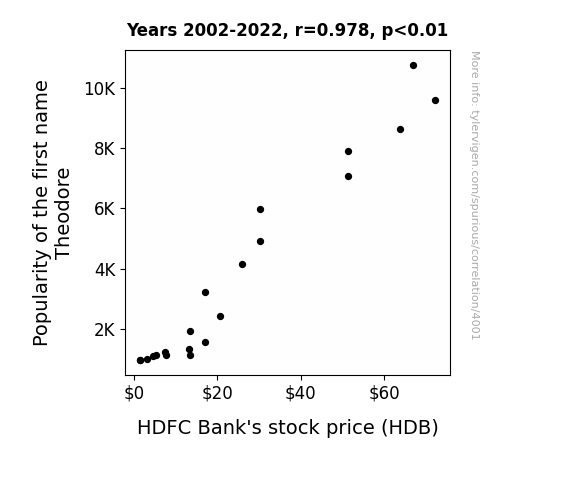
What else correlates?
Popularity of the first name Theodore · all first names
HDFC Bank's stock price (HDB) · all stocks
Popularity of the first name Theodore · all first names
HDFC Bank's stock price (HDB) · all stocks


View details about correlation #1,192

What else correlates?
Bachelor's degrees awarded in Liberal arts · all education
xkcd comics published about philosophy · all weird & wacky
Bachelor's degrees awarded in Liberal arts · all education
xkcd comics published about philosophy · all weird & wacky


View details about correlation #3,738

What else correlates?
Solar power generated in Belize · all energy
The number of fire inspectors in Florida · all cccupations
Solar power generated in Belize · all energy
The number of fire inspectors in Florida · all cccupations


View details about correlation #4,954
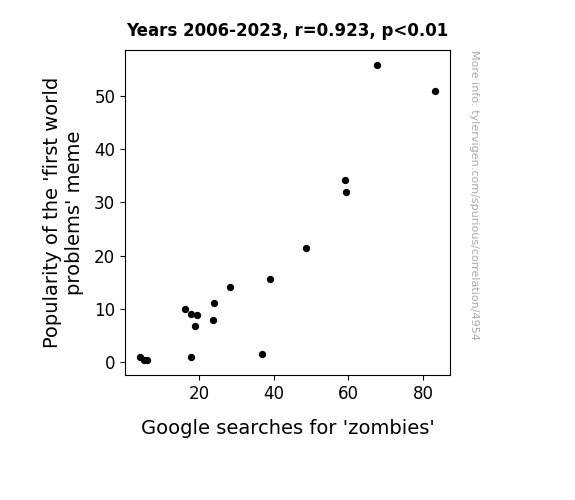
What else correlates?
Popularity of the 'first world problems' meme · all memes
Google searches for 'zombies' · all google searches
Popularity of the 'first world problems' meme · all memes
Google searches for 'zombies' · all google searches


View details about correlation #2,829
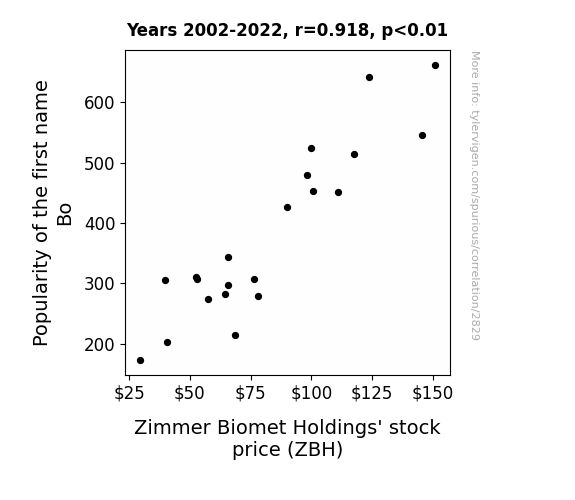
What else correlates?
Popularity of the first name Bo · all first names
Zimmer Biomet Holdings' stock price (ZBH) · all stocks
Popularity of the first name Bo · all first names
Zimmer Biomet Holdings' stock price (ZBH) · all stocks


View details about correlation #2,601
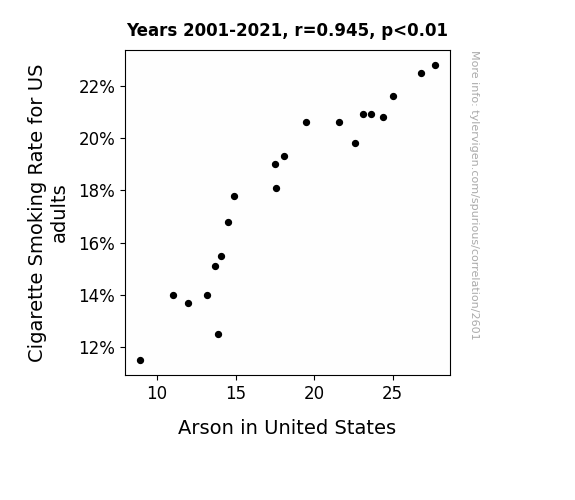
What else correlates?
Cigarette Smoking Rate for US adults · all weird & wacky
Arson in United States · all random state specific
Cigarette Smoking Rate for US adults · all weird & wacky
Arson in United States · all random state specific


View details about correlation #5,880



View details about correlation #1,076
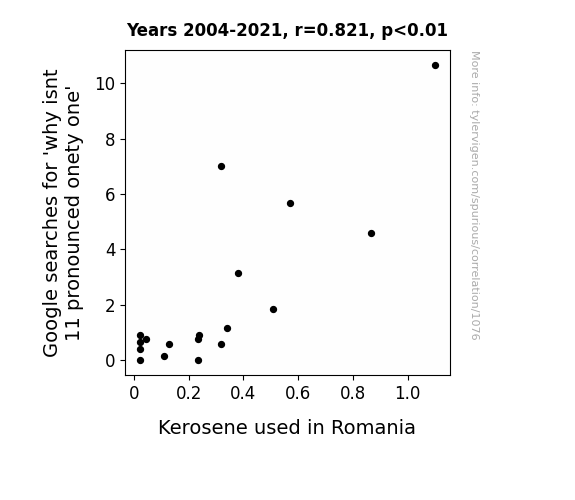
What else correlates?
Google searches for 'why isnt 11 pronounced onety one' · all google searches
Kerosene used in Romania · all energy
Google searches for 'why isnt 11 pronounced onety one' · all google searches
Kerosene used in Romania · all energy


View details about correlation #5,947
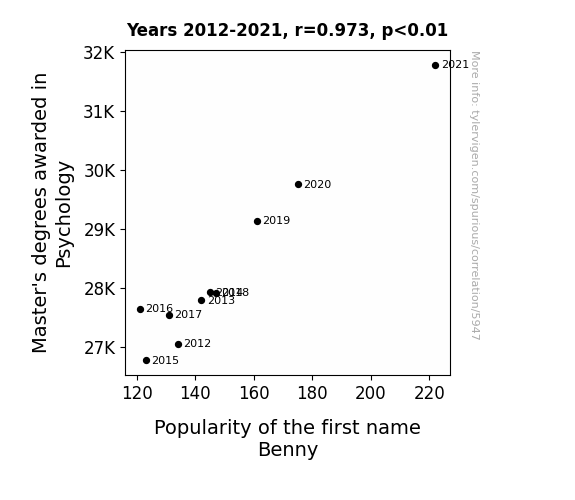
What else correlates?
Master's degrees awarded in Psychology · all education
Popularity of the first name Benny · all first names
Master's degrees awarded in Psychology · all education
Popularity of the first name Benny · all first names


View details about correlation #4,064



View details about correlation #5,045
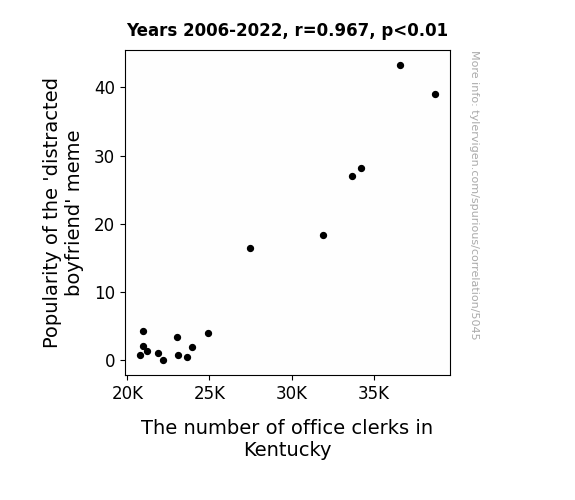
What else correlates?
Popularity of the 'distracted boyfriend' meme · all memes
The number of office clerks in Kentucky · all cccupations
Popularity of the 'distracted boyfriend' meme · all memes
The number of office clerks in Kentucky · all cccupations


View details about correlation #1,889
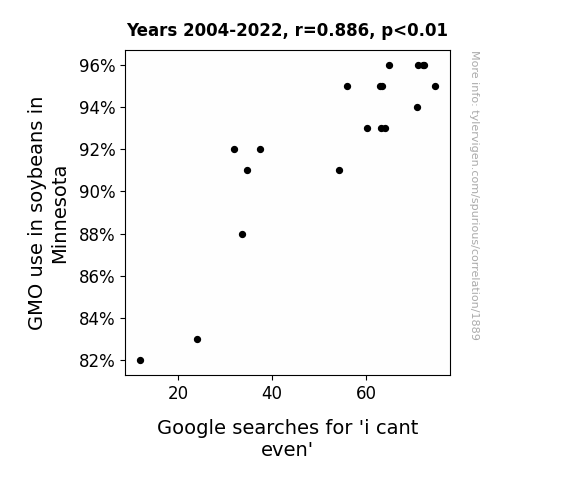
What else correlates?
GMO use in soybeans in Minnesota · all food
Google searches for 'i cant even' · all google searches
GMO use in soybeans in Minnesota · all food
Google searches for 'i cant even' · all google searches


View details about correlation #2,794
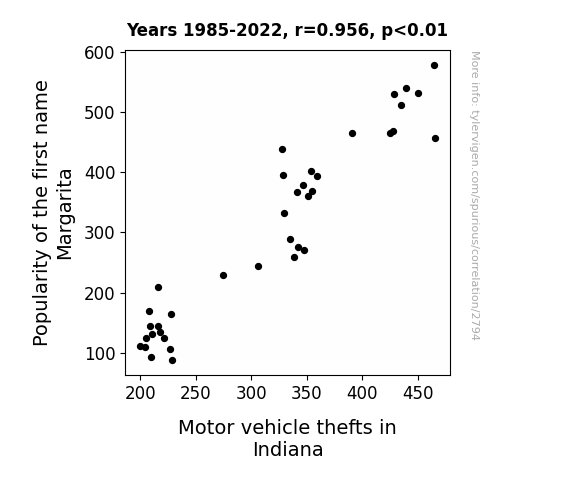
What else correlates?
Popularity of the first name Margarita · all first names
Motor vehicle thefts in Indiana · all random state specific
Popularity of the first name Margarita · all first names
Motor vehicle thefts in Indiana · all random state specific


View details about correlation #1,165
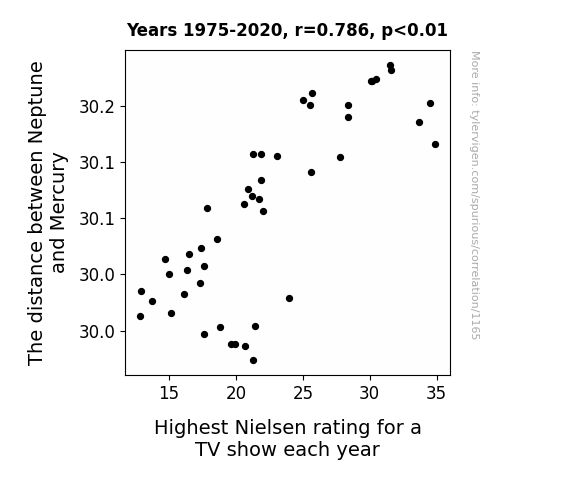
What else correlates?
The distance between Neptune and Mercury · all planets
Highest Nielsen rating for a TV show each year · all weird & wacky
The distance between Neptune and Mercury · all planets
Highest Nielsen rating for a TV show each year · all weird & wacky


View details about correlation #2,722



View details about correlation #1,104

What else correlates?
Google searches for 'who is jk rowling' · all google searches
The Coca-Cola Company's stock price (KO) · all stocks
Google searches for 'who is jk rowling' · all google searches
The Coca-Cola Company's stock price (KO) · all stocks


View details about correlation #5,924

What else correlates?
How insightful OverSimplified YouTube video titles are · all YouTube
Snowfall in Chicago · all weather
How insightful OverSimplified YouTube video titles are · all YouTube
Snowfall in Chicago · all weather


View details about correlation #2,599

What else correlates?
Popularity of the first name Killian · all first names
Automotive recalls for issues with the Air Bags · all weird & wacky
Popularity of the first name Killian · all first names
Automotive recalls for issues with the Air Bags · all weird & wacky


View details about correlation #2,246

What else correlates?
Butter consumption · all food
The number of epidemiologists in Colorado · all cccupations
Butter consumption · all food
The number of epidemiologists in Colorado · all cccupations
Why this works
- Data dredging: I have 25,237 variables in my database. I compare all these variables against each other to find ones that randomly match up. That's 636,906,169 correlation calculations! This is called “data dredging.”
Fun fact: the chart used on the wikipedia page to demonstrate data dredging is also from me. I've been being naughty with data since 2014.
Instead of starting with a hypothesis and testing it, I instead tossed a bunch of data in a blender to see what correlations would shake out. It’s a dangerous way to go about analysis, because any sufficiently large dataset will yield strong correlations completely at random. - Lack of causal connection: There is probably no direct connection between these variables, despite what the AI says above.
Because these pages are automatically generated, it's possible that the two variables you are viewing are in fact causually related. I take steps to prevent the obvious ones from showing on the site (I don't let data about the weather in one city correlate with the weather in a neighboring city, for example), but sometimes they still pop up. If they are related, cool! You found a loophole.
This is exacerbated by the fact that I used "Years" as the base variable. Lots of things happen in a year that are not related to each other! Most studies would use something like "one person" in stead of "one year" to be the "thing" studied. - Observations not independent: For many variables, sequential years are not independent of each other. You will often see trend-lines form. If a population of people is continuously doing something every day, there is no reason to think they would suddenly change how they are doing that thing on January 1. A naive p-value calculation does not take this into account.
You will calculate a lower chance of "randomly" achieving the result than represents reality.
To be more specific: p-value tests are probability values, where you are calculating the probability of achieving a result at least as extreme as you found completely by chance. When calculating a p-value, you need to assert how many "degrees of freedom" your variable has. I count each year (minus one) as a "degree of freedom," but this is misleading for continuous variables.
This kind of thing can creep up on you pretty easily when using p-values, which is why it's best to take it as "one of many" inputs that help you assess the results of your analysis.
- Y-axes doesn't start at zero: I truncated the Y-axes of the graphs above. I also used a line graph, which makes the visual connection stand out more than it deserves.
Nothing against line graphs. They are great at telling a story when you have linear data! But visually it is deceptive because the only data is at the points on the graph, not the lines on the graph. In between each point, the data could have been doing anything. Like going for a random walk by itself!
Mathematically what I showed is true, but it is intentionally misleading. If you click on any of the charts that abuse this, you can scroll down to see a version that starts at zero. - Confounding variable: Confounding variables (like global pandemics) will cause two variables to look connected when in fact a "sneaky third" variable is influencing both of them behind the scenes.
- Outliers: Some datasets here have outliers which drag up the correlation.
In concept, "outlier" just means "way different than the rest of your dataset." When calculating a correlation like this, they are particularly impactful because a single outlier can substantially increase your correlation.
Because this page is automatically generated, I don't know whether any of the charts displayed on it have outliers. I'm just a footnote. ¯\_(ツ)_/¯
I intentionally mishandeled outliers, which makes the correlation look extra strong. - Low n: There are not many data points included in some of these charts.
You can do analyses with low ns! But you shouldn't data dredge with a low n.
Even if the p-value is high, we should be suspicious of using so few datapoints in a correlation.
Pro-tip: click on any correlation to see:
- Detailed data sources
- Prompts for the AI-generated content
- Explanations of each of the calculations (correlation, p-value)
- Python code to calculate it yourself



